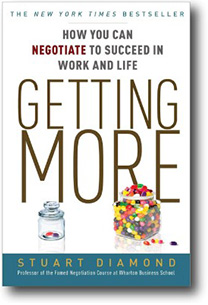Most people are not as successful, happy or persuasive as they wish because they have received bad advice since they were children on how to deal with others. Power. Leverage. Logic. Threats. Walking Out. Win-Win. Saying you have another offer. This advice is based on impersonal law and economics principles developed over 40 years ago. If you think that’s OK, try getting through the day in our fast-changing world with 40-year-old tools like a manual typewriter or rotary phone.
The Getting More model of human interaction has been developed with much more realistic, practical and recent methods of human psychology. Emotional intelligence. Cultural diversity. Understanding and valuing the other party’s perceptions, that is, the pictures in their heads. And it generates four times as much value – twice as many deals, and each deal gets twice as much. It’s an information collection system about the human psyche; the outcome is far better results for all parties. In addition to being persistently collaborative, it’s persistently fair.
The innovative Getting More model is gaining considerable traction around the world. Thousands of employees at major Silicon Valley companies been trained in the model and have brought in billions of dollars in extra revenues. U.S. Special Operations, the military elite, says that the model is saving lives. Job seekers have gotten more jobs and raises. Millions of discounts have resulted. And legions of parents have gotten their kids to go to bed on time or otherwise listen. All of them get through the day now with more confidence and calm.
-
“The best class at Wharton; it changed my life.”
Jim Vopelius, Vice President and Chief Financial Officer, Trident Risk Management
-
"Superb, counterintuitive, immensely useful.”
Kirkus Reviews
-
“Phenomenal.”
Lawyers Weekly
-
“Brilliant.”
Lisa Oz, Oprah Network
-
“A massive advantage in any negotiation.”
Stephanie Camp, Senior Digital Strategist, Microsoft

